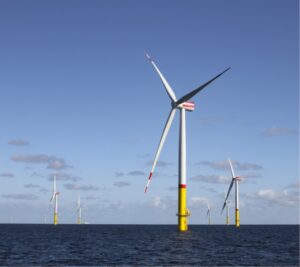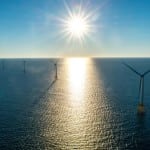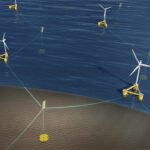
The reeling offshore wind power market received another blow as Mitsubishi Corp. said it will end further development of three Japanese offshore wind power projects due to rising costs.
Mitsubishi Chief Executive Katsuya Nakanishi on August 27 said cost increases for the installations had far surpassed the company’s projections. The company said the price of construction has more than doubled over the past few years after a consortium led by Mitsubishi won state auctions for the three wind farms in 2021. The installations, which had a projected capacity of 1.76 GW, were sited in Chiba and Akita prefectures and expected to enter commercial operation in the 2028 to 2030 time frame.
Nakanishi in a news briefing Wednesday said, “We thoroughly examined every possible measure, but compared to our bidding assumptions, costs more than doubled, making even investment recovery impossible. Even with countermeasures such as supply chain restructuring, we concluded that total expenditures—including maintenance and operational costs—would surpass electricity sales revenue, making project continuation difficult.”
Mitsubishi earlier this year announced it had logged a charge of 52.2 billion yen ($353 million) on the projects. Chubu Electric Power, a project partner, on Wednesday said it expected a loss of about 17 billion yen ($115 million) this fiscal year due to cancellation of the three installations.
‘Significantly Changed’ Business Environment
Mitsubishi issued a statement Wednesday regarding its decision to cancel the projects. The statement, which was emailed to POWER, in part read: “As announced in February 2025, MC [Mitsubishi Corp.] has been reviewing the business plans for these projects due to unexpected changes in the business environment. As a result of the review, we have decided not to proceed with the development of the projects.
“Since MC’s selection as the operator of these projects in December 2021, in the wake of the pandemic and the Ukraine crisis, the business environment for offshore wind power has significantly changed worldwide due to factors such as tight supply chains, inflation, exchange rates, and rising interest rates.
“To adapt to these unexpected changes, we have been pursuing various options including reassessment of costs, project schedule, and revenue. However, after discussions among the partners, we have determined that establishing a viable business plan is not feasible given the current conditions.
“The majority of the losses related to this matter have already been accounted for in prior years, and any additional losses are expected to be limited.”
Challenges for Offshore Wind
The Global Wind Energy Council in its flagship Global Offshore Wind Report, released earlier this year, said the offshore wind industry added 8 GW of capacity in 2024, the fourth-highest annual total ever. The group said 83 GW of offshore wind was installed globally through last year.
This year, though, has brought a myriad of challenges for the industry, including continued rants from U.S. President Donald Trump, a vocal opponent of offshore wind. Trump at a Cabinet meeting on Tuesday said, “We’re not allowing any windmills to go up. They’re ruining our country. They’re ugly, they don’t work, they kill your birds. They’re bad for the environment. And if you look at them from a house, your house is worth less than 50%. So I’m trying to have people learn about wind real fast.”
The Trump administration earlier this month ordered a halt to the 704-MW Revolution Wind project off Rhode Island. That wind farm is about 80% complete. The stop work order sent shares of Orsted, the Denmark-based project developer, plunging, and brought warnings from power companies and grid operators of the impacts of such moves by the administration on the U.S. energy supply.
ISO New England, the regional grid operator most impacted by the Revolution Wind stoppage, issued a statement on August 25 that said in part: “As demand for electricity grows, New England must maintain and add to its energy infrastructure. Unpredictable risks and threats to resources—regardless of technology—that have made significant capital investments, secured necessary permits, and are close to completion will stifle future investments, increase costs to consumers, and undermine the power grid’s reliability and the region’s economy now and in the future.”
The Trump administration in a court filing on August 22 said it also wants to block a wind project off the coast of Maryland. The Maryland Offshore Wind Project was approved by the Biden administration in September of last year.
Mitsubishi Considers Future Steps
Nakanishi on Wednesday said Mitsubishi is still committed to its decarbonization goals. The executive, though, but did not say whether the company would again pursue offshore wind projects in Japan.
The company’s statement on Wednesday said, “We continue to recognize renewable energy, including offshore wind power, as an essential element of Japan’s energy mix. We remain committed to working toward the realization of a decarbonized society while closely monitoring the business environment.”
Japan has a goal of at least 10 GW of installed offshore wind generation capacity by 2030, and 45 GW by 2040. Other companies that have won auctions to build installations in Japanese waters include BP, Iberdrola, and RWE. BP already has announced a pullback in its pursuit of renewable energy, and has laid off thousands of workers as it refocuses on its core oil and gas business.
RWE has paused its 2.8-GW Community Offshore Wind project, a planned venture with National Grid off the New York coast. Markus Krebber, the company’s CEO, has said the company is hedging against actions by the Trump administration against offshore wind. Unlike the Revolution Wind project, construction has not begun on the New York installation.
Japan wants to increase its use of renewable energy resources to reduce its dependence on imports of liquefied natural gas (LNG). The country is the world’s second-largest buyer of LNG, behind only China. Government officials have warned of the economic and other impacts of continuing to rely on LNG, which gained in importance after Japan shut down all the country’s nuclear reactors following the Fukushima disaster caused by a tsunami in 2011. The country has slowly been bringing nuclear power back online.
Yoji Muto, head of Japan’s Ministry of Economy, Trade and Industry, on Wednesday said Mitsubishi’s cancellation of the offshore wind projects is “deeply regrettable.” Muto said, “This withdrawal betrays local expectations and risks undermining public trust in offshore wind power.” The minister said the government would pursue another auction for the three sites.
—Darrell Proctor is a senior editor for POWER.










